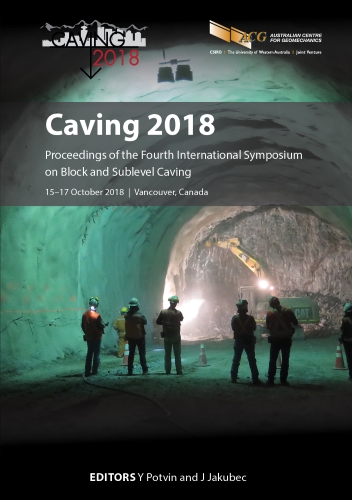Grasberg Block Cave mine: cave planning and undercut sequencing

|
Authors: Beard, D; Brannon, C |
DOI https://doi.org/10.36487/ACG_rep/1815_26_Beard
Cite As:
Beard, D & Brannon, C 2018, 'Grasberg Block Cave mine: cave planning and undercut sequencing', in Y Potvin & J Jakubec (eds), Caving 2018: Proceedings of the Fourth International Symposium on Block and Sublevel Caving, Australian Centre for Geomechanics, Perth, pp. 373-384, https://doi.org/10.36487/ACG_rep/1815_26_Beard
Abstract:
Construction and development of the Grasberg Block Cave (GBC) mine continues to progress, with undercutting commencing in late 2018. As an experienced operator of block cave mines, PT Freeport Indonesia (PTFI) works to improve the planning and execution of undercutting. The GBC mine, with its large size and complex geotechnical conditions, requires increased focus on initiating and sustaining caving. For the past two years, PTFI has worked on developing a software tool for detailed undercut planning. The tool utilises cave management rules, the geologic block model, and ring shapes to produce detailed tonnage and grade schedules. Additionally, further analytical processing of the tool’s output data allows examination of the feasibility and required resources to implement the undercutting plan. As a constraint-based scheduling application, the tool provides a high degree of flexibility in adapting quickly to changing assumptions. Factors affecting GBC undercutting include high tonnage rates, mine development resources, and variable rock mass conditions. Of primary concern, with production targets between 130,000 and 160,000 tpd, drawbells must open at a sufficient pace to achieve acceptable caving production ramp-up and then maintain throughput targets. Detailed undercut scheduling alleviates those concerns by optimising production block start dates, caving rules, and ring designs, to drive cave production with an achievable drawbelling rate. These detailed schedules also enable vetting of mine development plans, construction plans, and resource requirements. The GBC geotechnical environment requires undercutting strategies to adapt accordingly. Poor rock mass conditions, large panel boundaries, and high-stress conditions all affect undercut start points, caving directions, and other design decisions. The ability to produce realistic, detailed schedules enables further study of the impacts with 3D numerical modelling. Results from numerical modelling have helped refine not only the caving strategy, but also the overall mine design. The importance of the undercutting plan for successful caving of the large footprint, high tonnage rate GBC mine remains a priority. In conjunction with the geotechnical engineers and operations personnel, the mine planning team utilises the newly developed undercut planning tool to adapt and improve undercutting plans as more informed data becomes available. The geotechnical and operational challenges to mining the GBC necessitate the methods and approach to planning discussed in this paper.
Keywords: undercutting, scheduling, caving
References:
Brannon, CA, Firdausi, HH, Pascoe, ND & Yuniar, AT 2016, ‘Development and construction update of the Grasberg Block Cave mine’, Proceedings of MassMin 2016, The Australasian Institute of Mining and Metallurgy, Melbourne.
Dassault Systèmes Americas Corp. 2018, PCBC, computer software, Dassault Systèmes Americas Corp., Waltham, https://www.3ds.com/products-services/geovia/products/pcbc/
Villa, D, Brannon, CA, Dipas, CA & Vega, HA 2017, ‘Integrated drawbell and undercut scheduling using a computational tool at the Grasberg Block Cave mine’, Proceedings of the 13th AusIMM Underground Operators’ Conference 2017, The Australasian Institute of Mining and Metallurgy, Melbourne.
© Copyright 2025, Australian Centre for Geomechanics (ACG), The University of Western Australia. All rights reserved.
View copyright/legal information
Please direct any queries or error reports to repository-acg@uwa.edu.au
View copyright/legal information
Please direct any queries or error reports to repository-acg@uwa.edu.au
